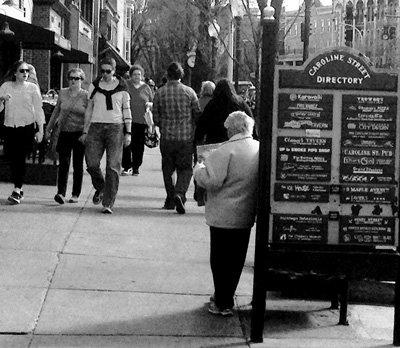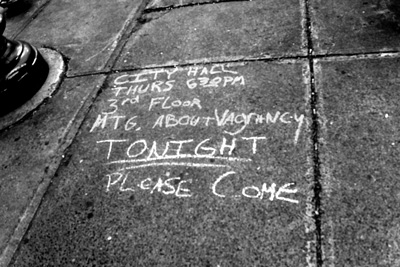News & Issues June 2016
Busy downtown is destination — for panhandlers
Saratoga Springs weighs new limits on sidewalk solicitation, vagrancy
 By THOMAS DIMOPOULOS
By THOMAS DIMOPOULOS
Contributing writer
SARATOGA SPRINGS, N.Y.
A panhandler, leaning against the signboard at right, seeks donations from pedestrians on Broadway in Saratoga Springs. The city is debating new limits on what officials say is “agressive panhandling.”Thomas Dimopoulos photo
As the growth of Saratoga Springs has brought bigger crowds of pedestrians downtown over the past decade, the city has had to grapple with an unexpected sign of its success: an influx of street performers and panhandlers who see the city’s sidewalks as fertile ground.
Last year, business owners’ concerns about crowds congregating in front of storefronts prompted the City Council to adopt a buskers law, restricting where street performers could stand on city sidewalks.
This year, the city is turning its attention to what some say is a proliferation of “aggressive” panhandlers on downtown streets.
“I’m getting e-mails twice daily, if not more, from people being asked for money or made to feel unsafe in some way,” Mayor Joanne Yepsen said. “These aggressive panhandlers are using made-up stories: ‘Hey, I need $10 for a bus ticket to go back to my child’; ‘My mother’s just gone into the hospital, do you have any money to spare?’” Yepsen said. “For the most part, it’s a scam. Aggressive panhandlers are leaving our residents feeling unsafe. And that’s not OK.”
The issue was first raised in 2013 when members of the Downtown Business Association met with public safety officials to discuss concerns about panhandlers they believed were from the city’s homeless population.
The issue of homelessness complicates matters in the city that prides itself on being proactive regarding the needs of the homeless. For example, the city set up a wintertime Code Blue emergency shelter and also has set up a system aimed specifically at helping homeless veterans.
But Yepsen contends the panhandlers who’ve been the focus of recent complaints are not homeless.
“I want to be sure that we all agree there is a difference between homeless and panhandling,” she said. “The aggressive panhandlers we are seeing causing trouble are not homeless. We know that because some of our expert nonprofits are working with them.”
Instead, the mayor said, the problem panhandlers are coming from outside the city – drawn by the potential to earn easy money from the affluent crowds downtown.
“The aggressive panhandlers are not Saratogians,” Yepsen said. “They come into the city. And it’s a business. They take shifts, they often use scams and lies to ask you to give them money. They are not seeking services or help. The homeless, on the other hand, we work with very closely.”
Panhandlers vs. the homeless?
Michael Finocchi, the executive director of Shelters of Saratoga, agreed with the mayor’s assessment that problem panhandlers were not coming from the city’s homeless population.
“No city is exempt from homelessness,” said Finocchi, whose organization runs a 35-bed managed case center on the city’s west side and also oversees the wintertime Code Blue shelter. “No city is exempt from vagrants coming into town and leaving with money.”
Finocchi said he has seen panhandlers coming into Saratoga Springs and added that the local homeless population is angered by the presence of the panhandlers -- because public opinion tends to lump them together.
 City Public Safety Commissioner Chris Mathiesen suggested the distinction may be harder to draw.
City Public Safety Commissioner Chris Mathiesen suggested the distinction may be harder to draw.
“Some of the panhandlers may be homeless, some may not be,” Mathiesen said. “It’s hard to make a blanket statement. It’s a complex problem, and there are no wrong answers -- as long as people understand that there are rights that have to be respected. People need to be dealt with in a manner that respects them as individuals who have a right to life, a life that is unlike most of the lifestyles that most of us have.”
Late last month, the city Public Safety Department organized a public forum on “Vagrancy in Saratoga Springs” that was attended by about 75 people.
“The last few years, the issues of vagrancy and the issues of panhandling have become more of a problem,” Mathiesen said. “We never really had anything like this before, but Saratoga Springs has become an attractive place for people.”
In the weeks leading up to the Public Safety Department’s forum, some local people had begun pushing for the city to take a tougher stance against panhandling. An online petition launched in late April to “ban panhandling and begging” in the city secured nearly 500 signatures in its first month. Petition signers told of being annoyed, harassed and feeling threatened by panhandlers, and they urged the City Council to create an ordinance to make aggressive begging on public property a crime.
Specifically, the petition calls for the city to vigorously enforce existing ordinances against loitering, public urination and defecation – and to provide local police with increased funding to conduct comprehensive, year-round enforcement efforts downtown and at all public parking garages.
In addition, a group of about 40 people staged a gathering at the City Center to launch a coordinated community effort to “dramatically reduce panhandling and vagrants” in Saratoga Springs. This group appointed the Saratoga Chamber of Commerce to form a working group of “stakeholders” to come up with solutions and ensure action.
Legal, constitutional tests
Many cities across the country are increasingly cracking down on panhandling. According to a Pew Charitable Trust analysis published in November, outright bans on panhandling rose by 25 percent between 2011 and 2014, while the number of cities with restrictions on begging in specified public places, such as near schools or banks, rose by 20 percent.
But panhandling bans have faced legal challenges on First Amendment grounds, and in some cases these laws have been ruled unconstitutional.
In Saratoga Springs, the challenge is to find a solution that’s workable and legal, Mathiesen said.
“What we’re trying to do is look at the laws and see if we can make some changes to our ordinances that will pass constitutional muster and something we can actually use to help address some of the problems associated with vagrancy,” he said. “People have a right to walk downtown without being pestered, and people have a right to walk downtown without others becoming aggressive about their panhandling.”
Saratoga Springs cannot simply outlaw panhandling. New York’s anti-loitering law, passed in 1964, was ruled unconstitutional three times by state and federal courts in the 1980s and 1990s. In New York City, where the law continued to be enforced despite the ruling, the city was ordered to pay $15 million to about 22,000 New Yorkers -- many of them homeless panhandlers – who were charged under unconstitutional “loitering” statutes between 1983 and 2012.
“In terms of people being on the sidewalks, and people panhandling, it’s a form of self-expression protected by the Constitution,” Mathiesen said. “We do have signs in our garages, which is city property. We have a right to keep people out of our garages for any reason other than parking cars. But aggressive panhandling is obviously a different issue.”
A license to beg?
City Accounts Commissioner John Franck said he’s witnessed incidents of public lewdness in recent years that were related to vagrancy.
“It’s gotten ridiculous,” Franck said. “It’s gotten really, really bad.”
He suggested that if the city can’t outlaw panhandling, it might try to license and regulate it.
“It’s legal to panhandle,” he acknowledged. “Why can’t we license it? You need a license to be a CPA. You need a license to sell hot dogs. You need a license to drive a cab. This way we can control it.”
Assistant City Attorney Tony Izzo said he’s currently researching the issue and has found a local law in Florida that requires panhandlers to obtain a license.
“As a practical matter, we’re not really sure how it would work,” he added.
Mathiesen said that for now, anyone who’s made to feel uncomfortable by the actions of others should call police to help settle the matter. Over the long haul, he and other city officials say they are seeking new solutions for incidents that blur the lines of panhandling, aggressive panhandling, and homelessness.
“The people we are dealing with routinely on the street, a lot of this is mental health related,” city Police Chief Gregory Veitch said. “A lot of this is addiction related. There is no policing our way out of this problem. These people do not need nightclubs and handcuffs; they need services in the long term.”
Complex challenge
Shelters of Saratoga houses guests for supervised stays of one to two months in a homelike environment; the shelter also provides support for its residents to put their lives back together and regain their independence. The facility also provides a drop-in center, one day each week, to nonresidents.
“The biggest factor in cleaning up the streets is having a place for folks to go during the day,” Finocchi said. “We can’t just pick up individuals and move them to another city. A lot these people suffer from mental illness. They’re not getting any medication, so what are they going to do? They’re going to self-medicate themselves through alcohol or drugs. Services need to be in place and provided for these individuals.”
The drop-in center fills an important gap, he said.
“We started this because we needed to have a place for people to go, and we’re averaging 13 people every Tuesday,” Finocchi said. “They come in, shower and do laundry, and most importantly we have case management there from other agencies in the city. If we can do this year-round, it can start to make a difference.”
City Finance Commissioner Michele Madigan said reducing the number of panhandlers likely will cost money.
“Throwing funding at the problem is obvious, but I think there are other things we can do,” Madigan said. “I spoke to the chief; he wants to put more officers on the street and have more targeted patrolling. He has indicated to me that could cost more money, more in overtime. I think that is an expense the city is willing to bear. That kind of model does deter people from aggressive panhandling. There are also some long-term things we can look at – affordable housing, real solutions that can help with our downtown problem.”
Another new initiative coordinated by the Saratoga County Chamber of Commerce and the city’s downtown assessment district will see a dozen homeless donation drop-boxes placed throughout the city by summer. The idea is that pedestrians will put money in the boxes, rather than giving cash directly to panhandlers on the street. Yepsen said money collected from the boxes will go directly to aiding the homeless, with no administrative costs deducted.
“This will provide the opportunity to say to the public that if they want to help the homeless, put the money in the drop box,” she said. “Do not give it to them directly. This should help with the problem right away.”
The City Council is expected to continue discussing solutions this month as Saratoga Springs’ busiest tourism season approaches.
“An action plan needs to be put in place, and we do need to look at new laws,” Yepsen said. “Begging is not illegal in New York state, but harassment is. Loitering is. The laws are being looked at, and I think the council should adopt any law that will protect the public from this.”
